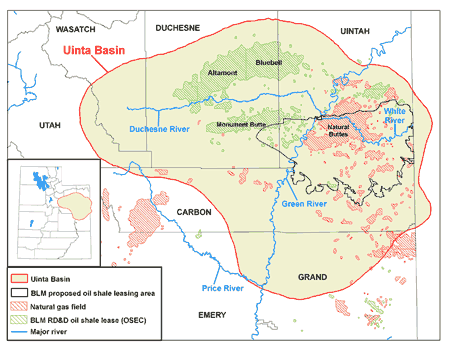Since the oil boom of the mid-1970s and the shale gas revolution of the mid-2000s, oil and gas producers have taken the industry to a whole new level, slowly changing the game worldwide. As a matter of fact, the application of hydraulic fracturing technology to the Bakken and other unconventional plays has revolutionized the industry by providing an economically viable way to recover crude oil from existing sources.
The Bakken, stretching 200,000 square miles under parts of Montana, North Dakota, Manitoba, and Saskatchewan, proved to be one of the most prolific sources of oil in the U.S. The USGS (United States Geological Survey)in April 2013 pegged the ultimate recovery at 7.4 billion barrels of oil.
A more accessible prominent resource play
As producers added prospective acres of land, several other discoveries were made, such as the Barnett shale, Eagle Ford, or more recently, the Niobrara shale. However, between all the exploration activities, a deposit of 3,834 square miles in Utah, discovered and explored between the end of World War II and the 1960s, quietly began to attract geologists and producers as well. This led to Chevron discovering the Red Wash field in 1951.

From the mid-1980s through the late-1990s, there was relatively low drilling activity due to low oil and gas prices until early 2000 where higher commodity prices made recovery way more attractive. That led the companies to be more interested in the region, where production of oil grew from 20,000 barrels per day in 2002 to 50,000 in 2011. The deposit has produced 630 million barrels of cumulative oil to date.
In 2004, U.S. government issued the first exploration and development agreement to provide access to tribal minerals in the central Uinta basin, an undeveloped area full of untapped resources. The basin has a potential original oil in place of 5,200 million barrels and a ultimate recovery at 1.32 trillion barrels of oil.

Anadarko Petroleum (APC +0.00%) is one of the major producing companies in the area, operating in the Greater Natural Buttes of the Uinta basin, one of the producer's major tight sands assets. Anadarko owns over 189,000 net acres of land and operates more than 2,400 wells. The company uses refrigeration and cryogenic processing facilities to extract NGL from its product stream. Furthermore, Anadarko has more than 8,000 lower-risk drill sites. For the second quarter of 2013, Anadarko had net sales volumes that averaged approximately 526 MMcfe/d for its operations in the Uinta basin.
Another major company in the area is also the largest oil producer in the state of Utah, with more than 30% of the state's oil production. Newfield Exploration (NFX +0.00%) owns 225,000 net acres of land that hold about a third of the company's total proved reserves. Newfield has seen its net production grow from 7,000 barrels of oil equivalent per day in 2004, to 20,000 in 2012. The company has over 6,800 remaining drilling locations left in the area, an estimation that could increase depending on its drilling success.
Uinta's underrated play brought also an underrated player in the mix: Crescent Point Energy (CPG +0.00%), a mid-cap Canadian company with tremendous potential. Crescent owns 173,000 net acres of land, the second largest among competitors in the region. The company has about 1,000 net locations in inventory and produced approximately 7,800 Boe/d in 2012. Of the annual average production of 114,000 Boe/d las year, Uinta represented more than 6.8%, and that ratio will grow as it further develops the area. Approximately 101.7 million barrels of oil are estimated in proved and probable reserves for this property. To date, only 0.2% of the resource is recovered in Uinta, which is proving to be an asset with tremendous potential for the company.
My Foolish two cents
Several plays in North America have been recognized to hold and produce substantial resources. Competition for quality position in these properties are fierce and the producers in place need to get the most out of its investment. In Uinta's case, drilling activity is more intense in the last decade as oil and gas prices are being high enough to sustain the costs for exploration and development activities.
Therefore, the Uinta basin represents a great opportunity since it holds a significant amount of resources in place that can be economically recovered with hydraulic fracturing and horizontal drilling technology. This underrated play could generates tremendous cash flow, which should make the involved producers' shareholders very happy in the process.